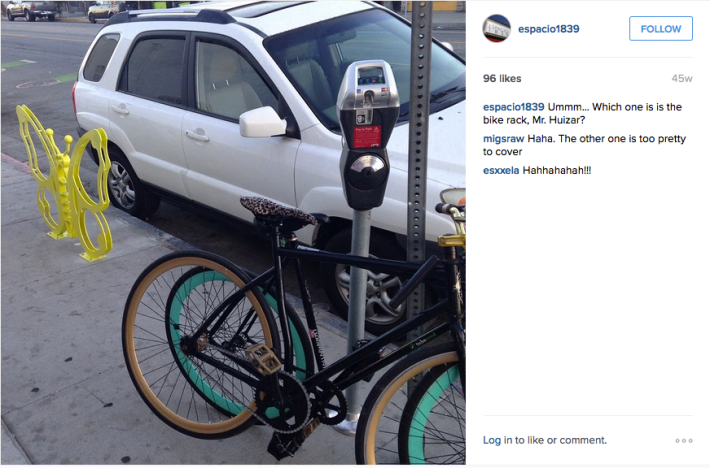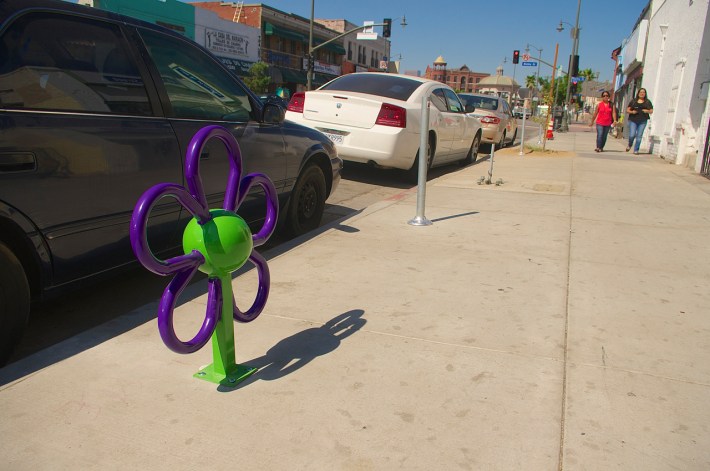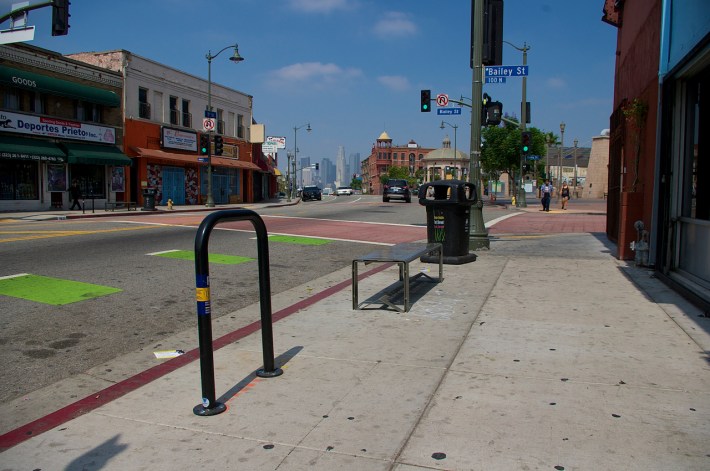
When the butterflies, flowers, and decorative benches first started popping up along 1st Street in Boyle Heights last year, reviews were mixed.
Okay...
That's not really true -- the reviews I heard were largely not that great.
Particularly from business owners that had been given some advance notice -- but no choice and no recourse -- about what would be appearing outside their front doors.

After the large ficus trees that had destroyed the street's sidewalks had been ripped out, the sidewalks repaired, and new trees planted, the colorful bike racks that appeared soon after were a bit incongruous with the new landscape.
The reference to the natural world served to point out just how devoid of greenery the street now was.

And while complaints did tend to highlight how garish the yellow butterflies were, the kicker, for many, was that the new racks and furniture were poorly placed and not particularly functional.
Some people didn't know what they were or preferred relying on parking signs.

Others (myself included) found the racks hard to use -- the awkward shape of the butterfly and the shortness of the flower coupled with the roundness of its center make them both complicated to lock up against, depending on the type of bike you have, how you lock your bike (I take off my back wheel), or whether another bike is already locked to it.

But the thing that made the least sense was the placement of the furniture.
Existing bike racks were removed from in front of Homeboys' continuation school -- where they were sorely needed -- and benches were placed in front of two bars that open at 6 a.m. Where benches appeared at other sites along the street, they were at some distance from the new trees which would have eventually provided shade.

And the bike racks appear to have been placed in the door zone at almost every opportunity.
Usually when I spot racks around the city, they tend to be placed in the red zones between parking spaces for cars so as not to block access either to cars or the bikes.
Not always.

But usually.
No such protocol appears to have been followed along 1st Street.




The situation is made worse when bikes are actually locked to the rack. A passenger might be able to maneuver around a rack. But bikes take up even more space in front of car doors and can present a challenge, particularly for folks with mobility issues or young children in car seats, or risk getting damaged by those who fling their doors open.

When I first asked about this problem with the street furniture last October, I was reassured by Paul Gomez, from the Public Affairs office at the Dept. of Public Works, that the initial placement locations were chosen by Metro design consultants with the help of the local advisory committee and the general public. And that the final placements were determined by Bureau of Street Services (BSS) designers (in consultation with Metro), first in accordance with the BSS' "Furniture Placement Requirements" guidelines and then reviewed and approved by the L.A. Department of Transportation Bikeway Section.
They saw no problem, in other words.
And yet, when I stopped by Espacio 1839 last week to say hello to a friend, the arrival of two new regular old bike racks outside their store, properly placed, seemed to signal recognition that there had indeed been a problem with the original racks.

Staff told me that when a Metro representative had come through to ask about how business owners felt about the new furniture (a few months after the original placement of the butterfly rack), they had spoken out about its poor placement.
The two new standard racks were meant to mitigate that problem (as was, it appears, the one that went in across the street in front of Deportes Prieto, top left in above photo).
But the butterfly rack still remains in place, and will likely stay there, as removing it would damage the new concrete (per Gomez' October correspondence with me). Meaning Espacio's sidewalk is now cluttered with extra street furniture. Considering that so many of the 30+ decorative racks along 1st St. are poorly placed, anyone else seeking to get more functional bike racks added to the street can expect to be contributing to clutter.

This is not exactly how the Eastside Access Project was supposed to go.
The butterflies, flowers, and benches are part of $12 million in improvements intended to "connect two key Boyle Heights [Metro] stations and the 1st Street commercial district currently separated by the I-5/I-10 freeway underpass and transform [the corridor] into an amenity and asset for Boyle Heights" and "transform the walking environment between Mariachi Plaza and Soto St. stations, making it a more enjoyable and safer place to walk." [See the full Eastside Access plan, here, and Metro's website for the project, here.]
The plan is supposed to be fully implemented by the end of 2015, according to a press release on a groundbreaking for decorative sidewalks sent out two years ago.
But it appears that much still remains to be done, including: the transformation of the corners at 1st and Cummings into placitas (below), the planting of the remainder of the 180 trees (two trees for every one of the 90 removed), the placing of fitness equipment, seating, curb extensions, and bike racks around the Evergreen Cemetery, the installation of shade elements, and the implementation of some of the more artistic elements of the plan, like the decorative sidewalks (promised in that 2013 press release), decorative bike lanes, and decorative guardrail panels around Metro stations.

As of this writing, there has been no word from Councilmember Jose Huizar's office on which of the remaining elements of the projects will be fulfilled, what the timeline for that might be, or whether the community (and the proper city agencies) will be consulted ahead of time to ensure that the improvements end up being viable.
There is no information about the project on the councilmember's website, either. The only thing resembling plans are found on Metro's website (or in this Metro Access Brochure from 2013) and those documents are quite outdated at this point.
Given Huizar's seemingly genuine effort to act as a champion for more livable streets, his important role in cheerleading for the Mobility Plan (just approved by the full City Council yesterday), and his dedication to making downtown more accessible for those on bike and on foot, the haphazard implementation of the Eastside Access project has been disappointing to see.
Hopefully, the councilmember's office will do better in steering the Great Streets plans for one of Boyle Heights' other key corridors, Cesar Chavez Ave. Those plans have not been released just yet, but Great Streets is holding an informational session tonight at Boyle Heights City Hall, from 6 to 8 p.m. Stakeholders are encouraged to stop by, hear about the plans, and meet some of the team that won the challenge grant to help transform the street. Great Streets will also be out on the corner of St. Louis and Cesar Chavez this Saturday, from 11 a.m. to 1 p.m.





